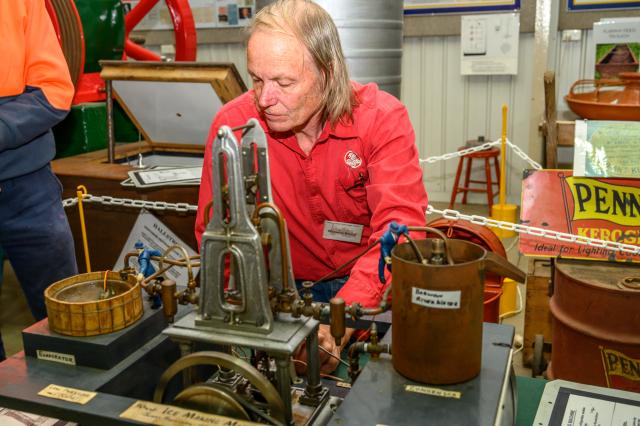
The movement promoting the influence and impact of Geelong’s Scottish-born innovator James Harrison continued to gain steam this week, with a presentation of a working model of one of his original inventions at the Geelong Showgrounds.
The event, held by the Royal Geelong Agricultural & Pastoral Society and the Geelong & Region Branch of The National Trust, Victoria (GRBNT), featured a roughly 1:10 scale model of Harrison’s first commercial ether vapour-compression ice-making machine made by engineer Warwick Bryce.
French documentary-maker, ARTE TV’s Basile Roze, was in attendance to film the model for the Invitation au Voyage program, which examines “exceptional destinations”, such as Geelong, “through different perspectives: culture, art, history, customs”.
The original steam-driven machine, invented and patented by Harrison in 1850s, pioneered the recycling principles of modern refrigeration, using the evaporative cooling of ether to freeze up to three tonnes of ice a day.
Harrison, who founded the Geelong Advertiser, was inspired to harness evaporative cooling when cleaning the metal type used in his printing press with sulfuric ether.
He had his ‘Eureka!’ moment when he blew on the ether-cleaned letters, forming ice crystals as the chemical evaporated.
Mr Bryce’s model, which he started working on 20 years ago, uses butane rather than the volatile ether, while today’s residential refrigeration units now mostly use freon.
Mr Bryce said Harrison, whose headstone reads “One soweth, another reapeth”, never saw great financial rewards for his pioneering work, despite leaving such an important legacy behind him.
“He did all the hard work, but never got rich from it,” Mr Bryce said.
“But what he did changed the way we all live.”
Harrison’s attempts to sell the ice-making machine and the patent in Britain and Europe were in vain, as the machine’s quickly-cooled ice was cloudy compared to naturally frozen ice used in the 19th century and perceived as impure.
Turning to the potential applications of commercial freezing, Harrison organised the first ever frozen meat shipment from Australia to England, intending to transport 25 tons of frozen meat on the Norfolk to London and intending to present the preserved food to Queen Victoria herself.
After investing heavily in the voyage and promoting it widely, Harrison became virtually bankrupt after saltwater breached the insulation tanks around the meat, spoiling it.
Lex Chalmers, OAM, chair of the GRBNT City of Design Sub-Committee, agreed with Mr Bryce that Harrison’s contributions deserved more recognition.
“We’ve all benefitted worldwide, and as (GRBNT president) Graham Hobbs says, every time you open the fridge for a beer you should say, ‘thanks James’,” she said.
“We are all still working on promoting Harrison’s legacy in refrigeration, and local interest in Harrison’s story is growing.”






